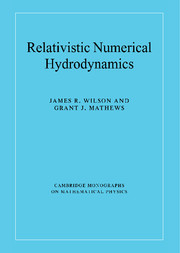7 - Hydrodynamics in three spatial dimensions
Published online by Cambridge University Press: 11 January 2010
Summary
Progress in computing full general relativistic hydrodynamics in three spatial dimensions has been slow. The problem is not in the hydrodynamics, but in the solution of the field equations. The equation for extrinsic curvature, Kij, is particularly unstable. For example, at the writing of this book no strong field fully relativistic calculation has computed more than two orbits of a neutron star binary without becoming unstable. Currently, there seems to be some promise, however, in a modified version of the ADM equations based upon a conformal decomposition as originally proposed by Shibata and Nakamura and later reinvented by Baumgarte and Shapiro. At the end of this chapter we briefly summarize this method for completeness. First, however, we summarize a useful alternative which the authors have developed for solving strong field systems which avoids the nonlinearities of the full Einstein equations by reducing the problem to an implementation of constraint equations.
The conformally flat approximation
For most gravitating systems studied so far (e.g.), only a relatively small amount of energy is emitted by gravitational waves. Even for the merger of two black holes it is expected that only a few tenths of a percent of the rest mass will be radiated away in gravitation. For the case of two neutron stars we would not expect any more radiation to be emitted during the last few orbits than for a two black hole merger, i.e. during the inspiral, the radiated energy per orbit is a minuscule fraction of the energy in orbital motion. Furthermore, an explicit treatment of the radiation reaction is exceedingly difficult.
- Type
- Chapter
- Information
- Relativistic Numerical Hydrodynamics , pp. 181 - 213Publisher: Cambridge University PressPrint publication year: 2003



